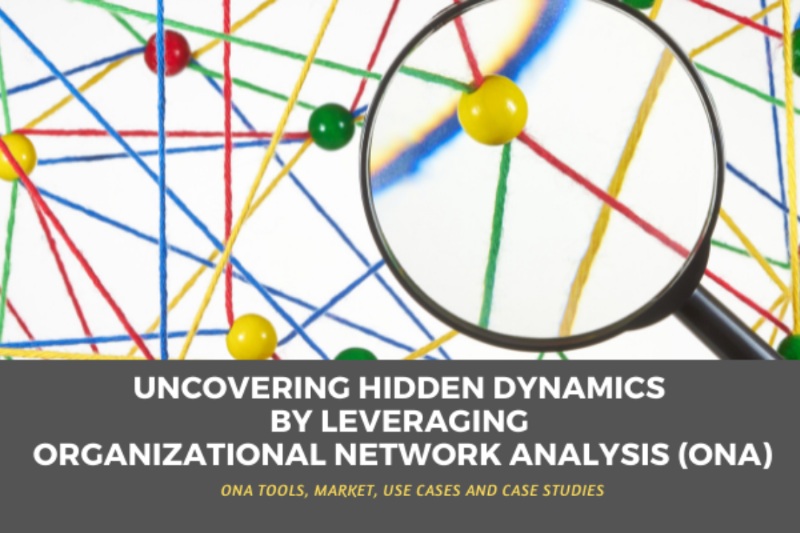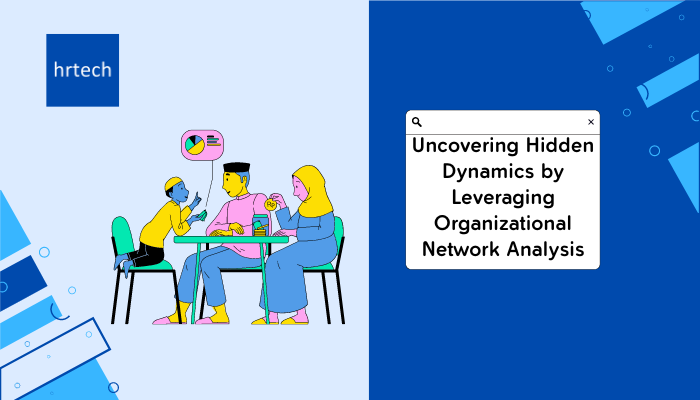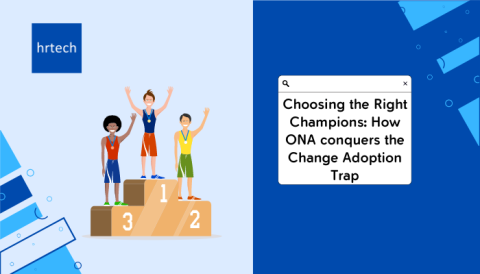ONA Tools, Market, Use cases and Case studies to help leaders uncover the hidden dynamics that drive performance by diving deep into the social capital of their organisation

The COVID-19 pandemic has changed the way organisations function. As they embrace the new way of work, they have been doubling down on their efforts to enhance employee engagement, productivity, communication and collaboration within the team and organisation. They are finding effective ways to dive deeper into the social capital and uncover the hidden dynamics that drive performance. Organisational Network Analysis (ONA) is the best way to achieve that.
ONA helps leaders find answers to the following questions –
- How does the information and communication follow in the organisation?
- How are teams and individuals collaborating with each other?
- Can we identify the most influential employees or teams and quantify their comparative impact?
- Who has been the most affected due to the pandemic?
- Are there signs of burnout?
- Are some employees at a higher risk of exit?
- Can we help employees be more productive?
Such Organisational Network Analysis questionnaires can provide valuable insights that can help organisations streamline their business model and drive an organisation wide digital and cultural transformation.
As organisations and leaders turn to a more data-driven approach of finding answers to these questions, they realise that talent issues lie beyond an individual’s behaviour, skills and capabilities.
What is Organisational Network Analysis?
ONA is a branch of People analytics that helps to understand how communication takes place in the organisation.
Renowned subject matter expert Professor Rob Cross explains “ONA can provide an x-ray into the inner workings of an organisation — a powerful means of making invisible patterns of information flow and collaboration in strategically important groups visible”.
Organizational network analysis (ONA) measures and graphs collaboration patterns by examining the strength, frequency and nature of interactions between people in networks. ONA provides detailed information about hidden factors for success, such as flow of information, decision-making, revenue producing collaborations, innovation, inclusion—even trust, purpose and energy.
Organizational Network Analysis (ONA) is a structured way to visualize how communications, information, and decisions flow through an organization. |
What are the Key Concepts in Organisational Network Analysis?
- Network size: For a given person, the number of connections. For a network, the number of persons in it.
- Network range: The number of connections within different business units and departments.
- Network strength: The strength of the relationship between people in the network.
- Network density: The number of connections between the members of the network.
- Network centrality: People with high centrality are directly connected with most of the other members of the network.
- Clusters: Group of individuals who are strongly connected. Information travels faster within a cluster.
- Connectors: Connectors are individuals who put in relation many members of the network.
- Brokers: Brokers are connectors who connect different groups/teams/clusters within the network.
- Gatekeepers: Individuals who control the interactions and flow of information going to their part of the networks.
- Choke points: Points in the network where the flow of interactions or information is slowed down or stopped.
- Central actors: Highly connected Individuals with a high degree of “centrality”.
- Outlier / peripheral actors: Peripheral team members who have limited connections with most of the network.
What are the Core Elements of Organisational Network Analysis?
Nodes: All the employees working in an organisation.
Central Node: These people seem to know everyone. Central nodes tend to share a lot of information, collaborate with different networks and influence groups quickly.
Knowledge Broker: They create bridges between groups to streamline the flow of information and ideas.
Peripheral: These people are easily overlooked and feel a lack of connection with their peers and the organisation. They are the most likely to exit.
Ties: Ties are formal and informal relationships between nodes (people).
Nodes and ties are the core elements of ONA. Visualizing the relationships between them makes it much easier to identify critical connections and potential barriers to information flow and collaboration.
Reference: Core elements of ONA. Source: Deloitte
How does Organization Network Analysis Work?
The effectiveness of ONA relies on the data available that helps in depicting the relationship between employees and teams within the organisation. Organizational Network Analysis is traditionally divided into two types – Active ONA & Passive ONA.
Active ONA uses direct input from employees in the organization as they are asked to answer a series of questions about their relationships with other employees. Here, data is collected explicitly by surveying employees whose collaboration habits are important for understanding the relationships that they have with other individuals within (or outside) the organisation.
Passive ONA, on the other hand, uses data that already exists within the enterprise- such as email logs, chat logs or in some cases even understanding who’s collaborating on certain documents.
Fig. 3: Active vs. Passive ONA – data sources and key characteristics. Source: David Green
Since both Active and Passive ONA data collection methods have some key differences and challenges, People Analytics Leader, David Green suggests that combining Active and Passive ONA is the way forward. Using survey-based Active ONA may produce great insights but can prove to be time-consuming and present a risk of low responses. However, adding Passive ONA to the mix will add scale, continuous and real-time capabilities.
When combined, the two data sets provide a revolutionary 360-degree view on how people feel AND what they do.
ONA TOOLS- People Analytics and ONA Market Landscape
In 2018, David Green categorised the vendors (Fig 4) driving innovation in the ONA space.
Fig. 4: ONA vendors in 2018. Source: David Green
In the HRTech Market 2021 report, Josh Bersin called out People Analytics and ONA as one of the key trends. Some key vendors in the People Analytics space listed in the report are (Fig. 5)
Fig. 5: HRTech Market 2021, People Analytics Vendors. Source: Josh Bersin
The People Analytics space and specifically the ONA space has grown, evolved and matured. The People Analytics Technology: Landscape Tool by Redthread Research helps PA leaders looking to invest in technology in 2021.
The PAT research study by Redthread research (Fig.6 ) focuses on 3 areas of market changes, vendor capabilities, and the considerations for making (or expanding) PAT investments.
Fig. 6: People Analytics Tech Market Solution Matrix | Source: RedThread Research, 2020.
The key findings of People Analytics Tool study 2020 included –
- People analytics tech solutions primarily focused on employee engagement, experience, D&I to address the customer needs in 2020;
- With over 121 PA technology solutions – the PA technology market, estimated at $2 billion, grew by over 35% between 2019 and 2020 alone;
- A majority of vendors anticipate that HRBPs and people managers will be using their solutions more frequently in the next 3 years;
- PA solutions capabilities include new-age technology, use of advanced NLP, deep machine learning, and the use of new and unstructured data.
How can ONA Tools Help Enterprise HR Teams?
As the People Analytics space is maturing and organisations are turning to data-driven methods for problem-solving and gathering workplace insights, ONA tools and their applications are becoming increasingly innovative.
Right from enhancing communication and collaboration to discovering the strengths and weaknesses of individuals and teams, ONA tools provide actionable insights. HR leaders can measure the impact of various development programs and bridge performance gaps by detecting problems and patterns of misalignments.
With ONA tools at their disposal, organisations and leaders can promote rapid innovation. Read more about how HR teams can leverage ONA tools to enhance digital interactions here.
GETTING STARTED
5 steps for Conducting an Organizational Network Analysis by Prof. Rob Cross:
- Identify a strategically important group.
- Assess meaningful and actionable relationships.
- Visually and quantitatively analyze results.
- Create meaningful feedback sessions.
- Assess progress and effectiveness
Also, organisations or HR Teams should consider four key aspects before getting started
- Get a clear objective or hypothesis you would like to test or collect data on.
- Define the relationship and metrics, derive the data you need.
- Consider legal and ethical implications
- Communicate with your employees early and often.
CONCLUSION
Organisational Network Analysis tools can simplify the complexities revolving around organisation-wide communication and virtual collaboration by helping HR teams and leaders understand and quantify certain areas- like TRUST, RELATIONSHIPS, COLLABORATION- that have traditionally been difficult to measure.
These tools also help uncover potential gaps in performance, boost productivity, promote innovation, improve communication & collaboration, identify influencers, support D&I initiatives and even contribute to employee wellbeing by detecting burn out.
To reap maximum benefits of the Organisational Network Analysis Tools, it’s necessary to start with the WHY while strategizing the ONA plan.
It is also important to think about how data can be leveraged to make data-driven decisions for organisation-wide impact, for the people and for the organisation as a whole.
ADDITIONAL RESOURCES BY hrtech
At hrtech we identified ONA as a key trending HRTech tool for 2021. Some other ONA related resources from hrtech.sg include:
- ONA Demo Hour (April 2021): ONA solution providers Cognitive Talent Solutions, OrgMapper and Panalyt in this on-demand Demo Hour where they share cutting edge solutions and discuss how their tools can address the ever changing demands of HR teams.
- ONA Infographic which gives a quick snapshot of ONA and the Ways Enterprise HR Teams can leverage ONA tools.
References:
- Core Elements of Organisational Network Analysis: Key Concepts of Network Analytics,Source: Mercer
https://mobilityexchange.mercer.com/insights/article/talent-mobility-and-people-analytics-collaboration-networks - Core elements of ONA. Source: Deloitte
https://www2.deloitte.com/us/en/pages/human-capital/articles/organizational-network-analysis.html - Active vs. Passive ONA – data sources and key characteristics. Source: David Green
https://www.myhrfuture.com/blog/2020/1/31/what-is-the-difference-between-active-and-passive-ona - ONA vendors in 2018. Source: David Green
https://www.davidrgreen.com/blog/2018/7/8/data-driven-hr-3-organisational-network-analysis - People Analytics Tech Market Solution Matrix | Source: RedThread Research, 2020.
https://redthreadresearch.com/pat-tool/ - Professor Rob Cross lists 5 steps for Conducting an Organizational Network Analysis
https://gates.comm.virginia.edu/rlc3w/sna02.htm - HR Teams should consider four key aspects before getting started
https://towardsdatascience.com/organizational-network-analysis-a-beginners-guide-324d21322ed2 - 5 steps for Conducting an Organizational Network Analysis by Prof. Rob Cross:
https://gates.comm.virginia.edu/rlc3w/sna02.htm.
About the author :

Swechha Mohapatra (IHRP-CP, Associate CIPD) is Head of Consulting & Delivery at hrtech.sg and has more than 9 years of global experience in various Talent functions. She is a passionate HRTech evangelist, a member of IHRP HRTech CoP Taskforce, and an avid learner who is certified Six Sigma-Green Belt with a background of MBA (Specialization in HR and IT) and Master’s in Labor Laws and Labor Welfare.



